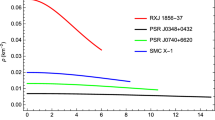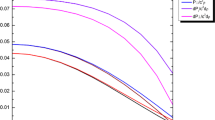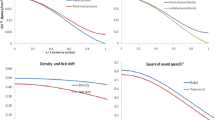Abstract
In the present article we have obtained a class of analytical solutions for an anisotropic charged fluid distribution. The neutral anisotropic fluid sphere has already been obtained by Maurya and Gupta (Phys. Scr. 86:025009, 2012). The solutions depend upon both the anisotropic and the charge parameter. The anisotropy parameter and the electric intensity is zero at the centre and monotonically increasing towards the pressure free interface. All the physical entities such as energy density, radial pressure, tangential pressure, and velocity of sound are monotonically decreasing towards the surface.
Similar content being viewed by others
Avoid common mistakes on your manuscript.
1 Introduction
The assumption of local isotropy is a common one in astrophysical studies of massive celestial objects. However, the theoretical investigation of Ruderman (1972) and Canuto (1973) of more realistic stellar models indicates that stellar matter may be anisotropic at least in certain density ranges (ρ<1015 g cm−3). According to them the radial pressure may not be equal to the tangential pressure in such anisotropic massive bodies.
Certainly no astronomical object has a perfect fluid distribution. Therefore it seems worthwhile to study the behaviour of the anisotropic fluid sphere in general relativity. Anisotropy in the pressure could be introduced by the existence of a solid core, by the presence of type-3A superfluid (Kippenhahn and Weigert 1990), different kinds of phase transitions (Sokolov 1980) or by other physical phenomena. On the scale of galaxies, Binney and Tremaine (1987) have considered anisotropies in spherical galaxies, from a purely Newtonian point of view. The mixture of two gases (e.g. monatomic hydrogen or ionised hydrogen and electrons) can also formally be described as an anisotropic fluid (Letelier 1980 and Bayin 1982). Bowers and Liang (1974) have investigated the possible importance of locally anisotropic equations of state for relativistic fluid spheres by generalising the equations of hydrostatic equilibrium to include the effects of local anisotropy.
Relativistic stellar models have been studied ever since the first solution of Einstein’s field equation for the interior of a compact object in hydrostatic equilibrium was obtained by Schwarzschild in 1916. The search for the exact solutions describing a static isotropic and anisotropic stellar type configuration has continuously attracted the interest of physicists. The study of general relativistic compact objects is of fundamental importance for astrophysics. After the discovery of pulsars and the explanation of their properties by assuming them to be rotating neutron stars, the theoretical investigation of super-dense stars has been done using both numerical and analytical methods, and the parameters of neutron stars have been worked out by a general relativistic treatment.
In the present paper we consider a class of exact solutions of the gravitational field equations for an anisotropic charged fluid sphere, corresponding to a specific choice of the anisotropy parameter and electric intensity. The importance of charge is due to the following reasons:
-
(i)
The presence of some charge may avert the gravitational collapse by counter-balancing the gravitational attraction by the electric repulsion in addition to the pressure gradient.
-
(ii)
The charge dust models and electromagnetic mass models provide information as regards the structure of the electron (Bijalwan 2011) and the lepton model (Kiess 2012).
It is desirable to study the Einstein–Maxwell field equations with reference to the general relativistic prediction of gravitational collapse with anisotropic matter.
All the physical parameters like the energy density, pressure and metric tensor components are regular inside the charged anisotropic star, with the speed of sound less than the speed of light. Therefore this solution can give a satisfactory description of realistic astrophysical compact objects like neutron stars. Some explicit numerical models of relativistic anisotropic stars, with possible astrophysical relevance, are also presented.
2 Field equations
Let us consider the static, spherically symmetric line element in curvature coordinates
where λ=λ(r) and ν=ν(r). We have
where vi is the fluid four-velocity vector for both the energy-momentum tensor, and xi is the unit space-like vector orthogonal to vi.
In the co-moving system we choose
From vi v i =xi x i =1, we obtain
The non-vanishing components of \(T_{j}^{i}\)are
The field equation (2) gives the following set of equations under the metric (1):
where the prime denotes differentiating with respect to r, while pr(r), pt(r) and ρ(r) are radial pressure (in the direction of x i ), tangential pressure (orthogonal to x i ) and energy density, respectively, for the anisotropic fluid. On the other hand E (\({=}\frac{q}{r^{2}}\)) denotes the electric intensity of anisotropic perfect fluid distribution. Also the q is given by
representing the total charge contained within the sphere of radius r. Also F14 is the only non-vanishing component of the skew-symmetric electromagnetic tensor F ij .
We assume pr≠pt. The case in which pr=pt corresponds to the isotropic fluid sphere. Δ=pt−pr is a measure of the anisotropy and is called the anisotropy factor (Herrera and Ponce de Leon 1985). The term 2(pt−pr)/r appears in the conservation equations \(T_{k; i}^{i} = 0\) (where a semicolon denotes the covariant derivative with respect to the metric), representing a force that is due to the anisotropic nature of the fluid. This force is directed outward when pt>pr and inward when pr>pt. The existence of a repulsive force (in the case in which pt>pr) allows for the construction of more compact objects when using an anisotropic fluid rather than when using an isotropic fluid (Gokhroo and Mehra 1994).
Subtracting Eq. (4) from Eq. (5) we immediately get
Equation (6) reveals the equivalence of the anisotropy parameter Δ=κ(pt−pr).
Also the solution of Eq. (6) with the given expression of Δ may provide the anisotropic fluid distribution.
Using the transformations ψ=c0r2 (c0 is a positive constant), e−λ=V and eν=Y2, Eqs. (3)–(6) assume the forms
and
Now let us consider the anisotropic model obtained by Maurya and Gupta (2012), which has
On inserting Y and Δ and \(\frac{2c_{0}q^{2}}{\psi^{2}}\)from (11) into Eq. (10) we get
This admits the solution
where
for all n<j. We have
and
here
Consequently the expressions for the density and pressure gradient read
where
where
and
with
In order to be physically meaningful, the interior solution for static fluid spheres of Einstein’s gravitational-field equations must satisfy some more general physical requirements. The following conditions have been generally recognised to be crucial for anisotropic fluid spheres; see Herrera and Santos (1997).
-
(i)
The solution should be free from physical and geometric singularities and non-zero positive values of eλ and eν i.e. (eλ)r=0=1 and eν>0.
-
(ii)
The radial pressure pr must be vanishing but the tangential pressure pt may not vanish at the boundary r=a of the sphere. However, the radial pressure is equal to the tangential pressure at the centre of the fluid sphere.
-
(iii)
The density ρ and pressure pr, pt should be positive inside the star.
-
(iv)
We should have (dpr/dr)r=0=0 and (d2 pr/dr2)r=0<0 so that the pressure gradient dpr/dr is negative for 0<r≤a.
-
(v)
We should have (dpt/dr)r=0=0 and (d2 pt/dr2)r=0<0 so that the pressure gradient dpt/dr is negative for 0<r≤a.
-
(vi)
Furthermore we should have (dρ/dr)r=0=0 and (d2 ρ/dr2)r=0<0 so that the density gradient dρ/dr is negative for 0<r≤a.
The condition (iv), (v) and (vi) imply that the pressure and density should be maximum at the centre and monotonically decreasing towards the surface.
-
(vii)
Inside the static configuration the speed of sound should be less than the speed of light, i.e.
$$0 \le \sqrt{\frac{\mathrm{d}p_{\mathrm{r}}}{c^{2}\,\mathrm{d}\rho}} < 1 \quad \mbox{and} \quad 0 \le \sqrt{ \frac{\mathrm{d}p_{\mathrm{t}}}{c^{2}\,\mathrm{d}\rho}} < 1. $$
In addition to the above the velocity of sound should be decreasing towards the surface. i.e. \(\frac{\mathrm{d}}{\mathrm{d}r} ( \frac{\mathrm{d}p_{\mathrm{r}}}{\mathrm{d}\rho} ) < 0\) or \(( \frac{\mathrm{d}^{2}p_{\mathrm{r}}}{\mathrm{d}\rho^{2}} ) > 0\) and \(\frac{\mathrm{d}}{\mathrm{d}r} ( \frac{\mathrm{d}p_{\mathrm{t}}}{\mathrm{d}\rho} ) < 0\) or \(( \frac{\mathrm{d}^{2}p_{\mathrm{t}}}{\mathrm{d}\rho^{2}} ) > 0\) for 0≤r≤a i.e. the velocity of sound is increasing with the increase of density.
-
(viii)
A physically reasonable energy-momentum tensor has to obey the conditions ρ≥pr+2pt and ρ+pr+2pt≥0.
-
(ix)
The central red shift Z0 and surface red shift Z a should be positive and finite i.e. Z0=[(e−ν/2−1)r=0]>0 and Z a =[eλ(a)/2−1]>0 and both should be bounded.
3 Properties of new class of solutions
We have
For
Consequently we have
Hence the velocity of sound at the centre is given by
and
which should be
The expression for the gravitational red shift Z is given by
For the central value of the gravitational red shift to be non-zero positive finite, we must have
Differentiating Eq. (23a) w.r.t. x, we get
The expression of the right hand side of (23b) is negative, and then the gravitational red shift is maximum at the centre and monotonically decreasing towards the surface.
4 Boundary conditions
Besides the above, the fluid ball is expected to join smoothly with the Schwarzschild exterior solution at the pressure free boundary r=a
which requires the continuity of eλ and eν across the boundary
and the radial pressure vanishes at the boundary i.e.
The condition (27) can be utilised to compute the value of the arbitrary constants \(\tilde{A}\) as follows.
On setting ψr=a=ψ a =c0a2 (a being the radius of the fluid balls), we see the following.
The radial pressure at pr(a)=0 gives
where
The expression for the mass can be written as
such that
where M=m(a) and
gives
Also, if the surface density ρ a is prescribed as 2×1014 g cm−3 (super-dense star case) then the value of the constant c0 can be calculated for a given ψ a (=c0a2), using the following expression:
with
5 Physical analysis and conclusion
In the present article we have obtained the charge anisotropic super-dense star subject to the relevant physical requirements. The maximum mass is seen to be increasing with the increasing values of 1≤n≤4. Thereafter for n>4, the maximum mass is monotonically decreasing; however, the minimum value of the maximum mass does no go below 2.7298M Θ . Therefore the overall maximum mass, found to be 3.9823M Θ at n=4 with the corresponding radius 18.2273 km for the whole range of the Chandrasekhar limit, regarding the mass-radius ratio holds well. Moreover, the condition ρ−pr−2pt≥0 is true for all the charged anisotropic star models. The radial velocity of sound (\(\sqrt{\mathrm{d}p_{\mathrm{r}}/\mathrm{d}\rho}\)) and the tangential velocity of sound (\(\sqrt{\mathrm{d}p_{\mathrm{t}}/\mathrm{d}\rho}\)) are found to be monotonically decreasing towards the pressure free interface for n≥1. The red shift for the whole family of super-dense stars is computed. For all the models the anisotropy parameter Δ=pt−pr is positive throughout the range and hence helps the outward pressure to avert the gravitational collapse of the super-dense star models thus obtained. It is worth pointing out here that the space-time, describing the current models as well as the seed anisotropic perfect fluid models, gives the relation nc0=constant=α. The above discussion helps us to write g44=B(1+c0r2)n as \(g_{44} = B(1 + \frac{\alpha}{n}r^{2})^{n}\), which tends to \(g_{44} = B \mathrm{e}^{\alpha r^{2}}\) as n→∞, which resembles the corresponding metric potential of the Kuchowichz space-time. The maximum mass of the charged anisotropic fluid models is shown in Tables 1(a), 1(b). For a better insight, the relevant physical quantities are presented by means of Tables 2, 4, 5, 6 and Figs. 1–6.
6 Tables for numerical values of physical quantities
References
Bayin, S.S.: Anisotropic fluid spheres in general relativity. Phys. Rev. D 26, 1262 (1982)
Binney, J., Tremaine, J.S.: Galactic Dynamics. Princeton University Press, Princeton (1987)
Bijalwan, N.: Astrophys. Space Sci. 336, 485 (2011)
Bowers, R.L., Liang, E.P.T.: Anisotropic spheres in general relativity. Astrophys. J. 188, 657 (1974)
Canuto, V.: In: Solvay Conf. on Astrophysics and Gravitation, Brussels (1973)
Gokhroo, M.K., Mehra, A.L.: Anisotropic spheres with variable energy density in general relativity. Gen. Relativ. Gravit. 26, 75 (1994)
Herrera, L., Ponce de Leon, J.: Isotropic and anisotropic charged spheres admitting a one-parameter group of conformal motions. J. Math. Phys. 26, 2302 (1985)
Herrera, L., Santos, N.O.: Local anisotropy in self-gravitating systems. Phys. Rep. 286, 53 (1997)
Kiess, T.E.: Astrophys. Space Sci. 339, 329–338 (2012)
Kippenhahn, R., Weigert, A.: Stellar Structure and Evolution. Springer, Berlin (1990)
Letelier, P.: Anisotropic fluids with two-perfect-fluid components. Phys. Rev. D 22, 807 (1980)
Maurya, S.K., Gupta, Y.K.: A family of anisotropic super-dense star models using a space-time describing charged perfect fluid distributions. Phys. Scr. 86, 025009 (2012)
Ruderman, R.: Pulsars: structure and dynamics. Annu. Rev. Astron. Astrophys. 10, 427–476 (1972)
Sokolov, A.I.: Phase Transitions in a Superfluid Neutron Fluid. J. Exp. Theor. Phys. 79, 1137 (1980)
Acknowledgements
The author S.K. Maurya is grateful to the referee for pointing out errors in original manuscript and making constructive suggestions. The author S.K. Maurya also acknowledges his gratitude to Prof. Bhaskar Bhattacharya, Dean SBSR, Sharda University for their motivation and encouragement.
Author information
Authors and Affiliations
Corresponding author
Rights and permissions
About this article
Cite this article
Maurya, S.K., Gupta, Y.K. A new class of relativistic charged anisotropic super dense star models. Astrophys Space Sci 353, 657–665 (2014). https://doi.org/10.1007/s10509-014-2041-5
Received:
Accepted:
Published:
Issue Date:
DOI: https://doi.org/10.1007/s10509-014-2041-5










